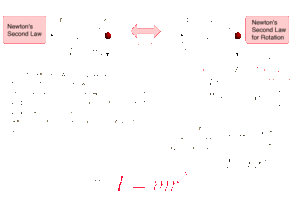The Moments of Inertia: Difference between revisions
(→Shpere) |
|||
| Line 15: | Line 15: | ||
The expression for the moment of inertia of a sphere can be developed by summing the moments of infintesmally thin disks about the z axis. The moment of inertia of a thin disk is | The expression for the moment of inertia of a sphere can be developed by summing the moments of infintesmally thin disks about the z axis. The moment of inertia of a thin disk is | ||
[[File:Sph2.gif]] [http://hyperphysics.phy-astr.gsu.edu/hbase/isph.html#sph4] | [[File:Sph2.gif]] [http://hyperphysics.phy-astr.gsu.edu/hbase/isph.html#sph4] | ||
===Thin Rod=== | |||
The moment of inertia calculation for a uniform rod involves expressing any mass element in terms of a distance element dr along the rod. To perform the integral, it is necessary to express eveything in the integral in terms of one variable, in this case the length variable r. Since the total length L has mass M, then M/L is the proportion of mass to length and the mass element can be expressed as shown. Integrating from -L/2 to +L/2 from the center includes the entire rod. The integral is of polynomial type: | |||
==Examples== | ==Examples== | ||
Revision as of 02:09, 1 December 2015
claimed by san47
Definition
Moment of inertia, denoted by the letter I, is another name for rotational inertia. It is associated with an object that is rotating about its center, or an axis. The moment of inertia for any rotating objects must be specified with respect to a chosen axis of rotation due to the varying distance r. The moment of inertia corresponds to mass for translational/linear motion. [1] [2]
A Mathematical Model

The moment of inertia is the sum of mass times the square of perpendicular distance to the rotation axis, that is [math]\displaystyle{ I=\Sigma mr^2 }[/math]for all point mass components. This relationship is the basis for all other moments of inertia since any object can be built up from a collection of point masses. [3] Note that I has units of mass multiplied by distance squared (kg⋅m2), as we might expect from its definition.
Moments of Inertia of Different Shapes

Hoop
The moment of inertia of a hoop or thin hollow cylinder of negligible thickness about its central axis is a straightforward extension of the moment of inertia of a point mass since all of the mass is at the same distance R from the central axis.[4]
Shpere
The expression for the moment of inertia of a sphere can be developed by summing the moments of infintesmally thin disks about the z axis. The moment of inertia of a thin disk is
 [5]
[5]
Thin Rod
The moment of inertia calculation for a uniform rod involves expressing any mass element in terms of a distance element dr along the rod. To perform the integral, it is necessary to express eveything in the integral in terms of one variable, in this case the length variable r. Since the total length L has mass M, then M/L is the proportion of mass to length and the mass element can be expressed as shown. Integrating from -L/2 to +L/2 from the center includes the entire rod. The integral is of polynomial type:
Examples
Be sure to show all steps in your solution and include diagrams whenever possible
Simple
Middling
Difficult
Connectedness
- How is this topic connected to something that you are interested in?
- How is it connected to your major?
- Is there an interesting industrial application?
History
Put this idea in historical context. Give the reader the Who, What, When, Where, and Why.
See also
Are there related topics or categories in this wiki resource for the curious reader to explore? How does this topic fit into that context?
Further reading
Books, Articles or other print media on this topic
External links
Internet resources on this topic